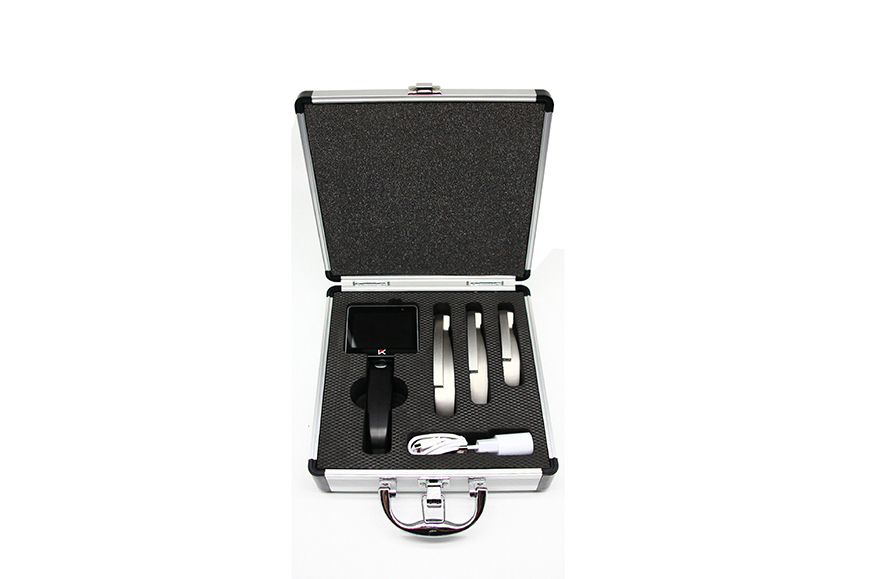What Is a Laryngoscope & Other FAQs:
Dec 11, 2024
——Everything You Need to Know
When you think about life-saving medical devices, what comes to mind? A defibrillator, perhaps, or an intravenous drip? But what about the humble laryngoscope? Often hidden in the background, this tool plays a crucial role in some of the most critical medical procedures. Whether in emergency rooms, intensive care units, or during anesthesia, the laryngoscope is indispensable. In this article, we’ll delve into What Is a Laryngoscope, the function, types, and important features of laryngoscopes, as well as answer some of the most frequently asked questions.
What Is a Laryngoscope?
What Is a Laryngoscope? A laryngoscope is a medical instrument used by healthcare professionals to examine the larynx (voice box) and facilitate the insertion of a tube into the airway, a process known as intubation. This procedure is crucial during surgeries that require general anesthesia or in emergency situations when the patient’s airway is compromised. Laryngoscopes help provide clear visibility of the vocal cords and trachea, enabling a smooth and safe intubation.
The Role of Laryngoscopes in Healthcare
Laryngoscopes are critical in various clinical settings, including intensive care units (ICU), neonatal intensive care units (NICU), emergency departments, and anesthesia departments. They allow medical professionals to manage patients’ airways effectively and safely, particularly in critical and life-threatening situations. Their design and function help ensure that the airway remains open during surgery or resuscitation efforts, which is crucial for maintaining adequate oxygen levels in the body.
Video Laryngoscopes: Advanced Technology for Better Intubation
In recent years, video laryngoscopes have revolutionized intubation procedures. These devices are equipped with a camera and a screen that display a real-time video feed of the larynx, making intubation quicker, easier, and safer. Video laryngoscopes are particularly beneficial for patients with difficult airways or those who have anatomical variations that make traditional laryngoscopy challenging.

Features of Video Laryngoscopes
One of the key benefits of video laryngoscopes is their enhanced visibility. These devices are equipped with a high-definition camera that provides a clear view of the vocal cords and trachea, allowing the practitioner to visualize the airway in real-time. The added clarity reduces the risk of complications such as airway trauma or incorrect tube placement. Furthermore, video laryngoscopes are often designed with smart features like anti-fog technology, ensuring that the camera lens remains clear throughout the procedure.
Portable Laryngoscopes for Emergency Situations
When it comes to emergency medical scenarios, mobility and portability are key. Portable laryngoscopes are compact, lightweight devices designed to be easily carried to the patient’s bedside or even in field situations. These laryngoscopes are equipped with high-quality light sources that enhance visibility, facilitating a quicker and safer intubation process in challenging environments.

Advantages of Portable Laryngoscopes
Portable laryngoscopes are indispensable in situations where every second counts, such as in paramedic or field use. Their slim, ergonomic design allows for easy handling, and their lightweight construction reduces the burden on medical professionals during high-pressure situations. Additionally, many portable laryngoscopes come with multiple blade sizes, making them versatile and adaptable for patients of different anatomies.
Laryngoscope Blades: Types and Compatibility
One of the defining features of a laryngoscope is its blade. Laryngoscope blades come in various shapes, sizes, and materials, each designed to cater to specific patient needs and clinical scenarios. The most common types of blades are the Macintosh and Miller blades, each offering unique advantages in different situations.

Blade Types and Sizes
Macintosh Blade: Curved in shape, the Macintosh blade is commonly used in adult patients and provides a clear view of the larynx with minimal effort.
Miller Blade: A straight blade, typically used in pediatric or neonatal intubation, providing a better view of the vocal cords in smaller patients.
Flexible Blades: Some laryngoscopes offer flexible blades, which provide additional maneuverability, particularly in difficult-to-intubate patients.
The versatility in blade options ensures that healthcare providers can use laryngoscopes across different age groups and anatomical variations.
Fiber Optic Laryngoscopes: Improved Visibility and Safety
Fiber optic laryngoscopes are equipped with fiber optic lighting, which provides superior illumination of the airway. The fiber optic technology ensures that the larynx is illuminated clearly, which is crucial for accurate and safe intubation. This technology minimizes the risk of trauma to the airway while offering a high level of visibility, especially in patients with difficult airways.

Benefits of Fiber Optic Laryngoscopes
Enhanced Visibility: The fiber optic light source offers bright, consistent lighting that improves the visibility of the vocal cords and trachea.
Reduced Trauma Risk: The design of fiber optic laryngoscopes minimizes pressure and tissue contact, which reduces the risk of injury during intubation.
Versatility: These laryngoscopes are available with a variety of blade sizes and styles, making them adaptable to both adult and pediatric patients.
The Importance of Ergonomics and Ease of Use
In a high-stress clinical setting, the design of a laryngoscope can significantly impact the ease and efficiency of the procedure. Many modern laryngoscopes are designed with ergonomic handles that provide a secure, comfortable grip. This is particularly important for ensuring control and precision during the intubation process.
Ergonomic Design for Better Control
Laryngoscopes with ergonomic handles allow healthcare professionals to maintain better control over the device, leading to a safer and more efficient intubation. Additionally, the slim and lightweight design of many portable laryngoscopes reduces the risk of fatigue, ensuring that practitioners can perform multiple intubations without sacrificing accuracy or comfort.
Maintenance and Hygiene: Ensuring Safety and Longevity
Laryngoscopes must meet strict hygiene and maintenance standards to prevent the spread of infections. Many laryngoscopes, including both video and fiber optic versions, come with detachable blades that can be easily sterilized. This ensures that the devices remain safe for use in multiple procedures.
Cleaning and Sterilization Protocols
Laryngoscopes made from medical-grade materials, such as 316 stainless steel, are highly durable and resistant to wear and tear. The ability to sterilize these devices makes them cost-effective for medical facilities, as they can be reused for many years. Ensuring proper cleaning and sterilization between uses is essential to maintain the highest standards of hygiene and prevent cross-contamination.
FAQs About Laryngoscopes
What are the main types of laryngoscopes?
There are primarily two types: direct laryngoscopes, which require the practitioner to visually inspect the airway directly, and video laryngoscopes, which provide a video feed to assist in visualization.
How do laryngoscopes help in intubation?
Laryngoscopes provide a clear view of the patient’s vocal cords and trachea, allowing for the correct placement of the endotracheal tube, which helps to secure the airway.
Can a laryngoscope be used in emergencies?
Yes, portable and video laryngoscopes are commonly used in emergency situations, including pre-hospital care by paramedics and in emergency departments, where rapid intubation is necessary.
Are video laryngoscopes more effective than traditional ones?
Video laryngoscopes offer enhanced visibility and greater ease of use, especially in challenging intubations. They allow for a more precise intubation, reducing the risk of complications.
What are fiber optic laryngoscopes?
Fiber optic laryngoscopes use fiber optic lighting to illuminate the airway, offering superior visibility while minimizing trauma to delicate tissues.
Conclusion
So do you know What Is a Laryngoscope now? Laryngoscopes are indispensable tools in modern medicine, providing healthcare professionals with the means to safely and effectively manage patients’ airways during critical procedures. Whether through video laryngoscopes that enhance visibility or fiber optic designs that reduce trauma, advancements in laryngoscope technology continue to improve patient outcomes. The portable and versatile nature of these devices makes them vital in emergency situations, and their ergonomic and hygienic designs ensure safe, efficient use across a range of clinical settings. For medical professionals and facilities, investing in high-quality laryngoscopes—like those from Mole Medical—can make all the difference in providing optimal patient care.
Categories
Latest Articles

Disposable Nephroscopes: Redefining Safety & Efficiency in Urology
Introduction The shift towards minimally invasive urological surgery has found a pivotal ally: the disposable nephroscope. As traditional reusable scopes grapple with persistent biofilm contamination risks and soaring sterilization costs, the global medical community is rapidly adopting single-use solutions. This article analyzes the clinical value, technological evolution, and dynamic innovation landscape driving this transformative shift. ... Read more

Disposable Video Laryngoscope Blades: The Ultimate Solution for Preventing Cross-Contamination
In the operating room, as the cold light of a video laryngoscope illuminates a patient’s airway, an age-old medical challenge is being redefined: How can life-saving instruments avoid becoming vectors of infection? Jiangsu MoleMedical drives an innovative safety revolution—replacing reusable devices with single-use, sterile laryngoscope blades that create a pure barrier for critical airways. Traditional video ... Read more
-2.jpg)
FDA & CE Approved Video Laryngoscope: What Makes It Stand Out?
Introduction In high-pressure emergencies and precision-driven operating rooms, video laryngoscopy is revolutionizing airway management. Mole Medical’s FDA and CE-certified technology replaces tactile-dependent “blind intubation” with real-time visual navigation – enhancing safety, accuracy, and clinical outcomes worldwide. Why Certification Matters Mole Medical’s dual certifications validate its global compliance and performance: FDA Clearance: Rigorous validation of safety/efficacy ... Read more

Mole Medical Showcases Advanced Endoscopy Solutions at CMEF Autumn 2025, Driving Global Partnerships
Guangzhou, China – September 26-29, 2025 – The 92nd China International Medical Equipment Fair (CMEF Autumn) concluded successfully on September 29th at the Canton Fair Complex in Guangzhou. Mole Medical Technology Co., Ltd. (Mole Medical) made a significant impact at the event, drawing global medical professionals and partners to its booth (Hall 2.1, Stand Q24) ... Read more

How to Use Disposable Ureteroscopes Safely and Efficiently
In the field of urology, the application of disposable electronic ureteral-kidney pelvis endoscopy catheters is leading the technological innovation in minimally invasive surgeries. According to the 2024 multi-center research data from China’s urology department, among the over 5,000 surgeries included, the patient group using disposable catheters performed significantly better in key indicators such as operation ... Read more



